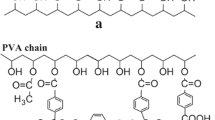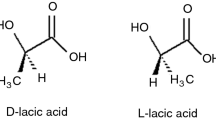Abstract
High temperature pyrolysis studies of poly(phenylene vinylene)s PPVs with lateral substituents poly(ε-caprolactone) (PPV–PCL) or poly(ε-caprolactone) and alternating Br (PPV–PCL–Br) or polystyrene (PPV–PSt) clearly showed that thermal stability of both the substituent and PPV were affected by the thermal stability of the other. In all the polymers under investigation, decomposition started by the degradation of the substituent. The thermal stability of the PPV backbone increased in the order PPV–PCL–Br < PPV–PCL < PPV–PSt. When the thermal stability of the substituent was significantly lower than that of the PPV backbone, as in the case of PPV–PCL and PPV–PCL–Br, then the radicals generated at early stages of pyrolysis coupled before the temperature reached to the values necessary for complete decomposition. This inturn yielded a thermally more stable crosslinked structure. The increase in thermal stability was greater upon coupling of the radicals generated on the PPV backbone.






Similar content being viewed by others
References
Yang Z, Sokolik I, Karasz FE. A soluble blue emitting polymer. Macromolecules. 1993;26:1188–99.
Zheng M, Ding L, Gürel EE, Karasz FE. Synthesis and electroluminescent studies of blue-emitting copolymers containing phenylene vinylene and oxadiazole moieties in the main chain. J Polym Sci A Polym Chem. 2002;40:235–41.
Hsieh BR, Yu Y, Forsythe EW, Schaaf GM, Feld WA. A new family of highly emissive soluble poly(p-phenylene vinylene) derivatives. A step toward fully conjugated blue-emitting poly(p-phenylene vinylenes). J Am Chem Soc. 1998;120:231–2.
Spreitzer H, Becker H, Kluge E, Kreuder W, Schenk H, Demandt R, et al. Soluble phenyl-substituted PPVs – New materials for highly efficient polymer LEDs. Adv Mater. 1998;10:1340–3.
Chen KB, Li HC, Chen CK, Yang SH, Hsieh BR, Hsu CS. Novel poly(2,3-biphenyl-1,4-phenylenevinylene) derivatives containing long branched alkoxy and fluorenyl substituents: synthesis, characterization, and their applications for polymer light-emitting diodes. Macromolecules. 2005;38:8617–24.
Yeh WL, Chen HL, Chen SA. Synthesis and spectral characterizations of electroluminescent poly(2,3-di-[p-(2’-ethylhexoxy)phenyl]-1,4-phenylenevinylene). Synth Met. 2007;157(10–12):407–13.
Demirel AL, Yurteri S, Cianga I, Yagci Y. Layered morphology of poly(phenylene)s in thin films induced by substitution of well-defined poly(epsilon-caprolactone) side chains. Macromolecules. 2005;38:6402–10.
Yurteri S, Demirel AL, Cianga I, Yagci Y. New polyphenylene-g-polystyrene and polyphenylene-g-polystyrene/poly(epsilon-caprolactone) copolymers by combined controlled polymerization and cross-coupling processes. J Polym Sci A Polym Chem. 2005;43:879–96.
Colak DG, Cianga I, Yagci Y, Cirpan A, Karasz FE. Novel poly(phenylene vinylenes) with well-defined poly(epsilon-caprolactone) or polystyrene as lateral substituents: synthesis and characterization. Macromolecules. 2007;40:5301–10.
Gedelian CA, Eyck GT, Lu T. Onset of thermal degradation in poly(p-phenylene vinylene) films deposited by chemical vapor deposition. Synth Met. 2007;157:48–52.
Ohnishi T, Murase I, Noguchi T, Hirooka M. Highly conductive graphite fil prepared from pyrolysis of poly(para-phenylene vinylene). Synth Met. 1986;14:207–13.
Nur Y, Yurteri S, Cianga I, Yagci Y, Hacaloglu J. Thermal degradation of poly(p-phenylene-graft-epsilon-caprolactone) copolymer. Polym Degrad Stab. 2007;92:838–48.
Nur Y, Yurteri S, Cianga I, Yagci Y, Hacaloglu J. Pyrolysis of polyphenylenes with PCL or/and PSt side chains. J Anal Appl Pyrolysis. 2007;80:453–9.
Nur Y, Colak DG, Cianga I, Yagci Y, Hacaloglu J. Pyrolysis of poly(phenylene vinylene)s with polycaprolactone side chains. Polym Degrad Stab. 2008;93:904–9.
Nur Y, Yurteri S, Cianga I, Yagci Y, Hacaloglu J. Direct pyrolysis mass spectrometry studies on thermal degradation characteristics of poly(phenylene vinylene) with well-defined PSt side chains. J Therm Anal Calorim. 2008;94:157–62.
Plage B, Schulten HR. Thermal degradation and mass spectrometric fragmentation processes of polyesters studied by time-resolved temperature-resolved pyrolysis field-ionization mass spectrometry. Macromolecules. 1990;23:2642–8.
Persenaire O, Alexandre M, Degee Dubois P. Mechanisms and kinetics of thermal degradation of poly(epsilon-caprolactone). Biomacromolecules. 2001;2:288–94.
Sivalingam G, Karthik R, Madras G. Kinetics of thermal degradation of poly(epsilon-caprolactone). J Anal Appl Pyrolysis. 2003;70:631–47.
Aoyagi Y, Yamashita K, Doi Y. Thermal degradation of poly[(R)-3-hydroxybutyrate], poly[epsilon-caprolactone], and poly[(S)-lactide]. Polym Degrad Stab. 2002;76:53–9.
Abe H, Takahashi N, Kim KJ, Mochizuki M, Doi Y. Effects of residual zinc compounds and chain-end structure on thermal degradation of poly(epsilon-caprolactone). Biomacromolecules. 2004;5:1480–8.
McNeill IC. Thermal degradation of polystyrene in different environments. Angew Makromol Chem. 1997;247:179–95.
Kannan P, Biernacki JJ, Visco DP. A review of physical and kinetic models of thermal degradation of expanded polystyrene foam and their application to the lost foam casting process. J Anal Appl Pyrolysis. 2007;78:162–71.
Poutsma ML. Mechanistic analysis and thermochemical kinetic simulation of the pathways for volatile product formation from pyrolysis of polystyrene, especially for the dimer. Polym Degrad Stab. 2006;91:2979–3009.
Acknowledgements
This work is partially supported by TUBITAK Research Fund TBAG-106T092.
Author information
Authors and Affiliations
Corresponding author
Rights and permissions
About this article
Cite this article
Nur, Y., Colak, D.G., Cianga, I. et al. High temperature pyrolysis of poly(phenylene vinylene)s with poly(ε-caprolactone) or polystyrene side chains. J Therm Anal Calorim 98, 527–532 (2009). https://doi.org/10.1007/s10973-009-0299-6
Received:
Accepted:
Published:
Issue Date:
DOI: https://doi.org/10.1007/s10973-009-0299-6




